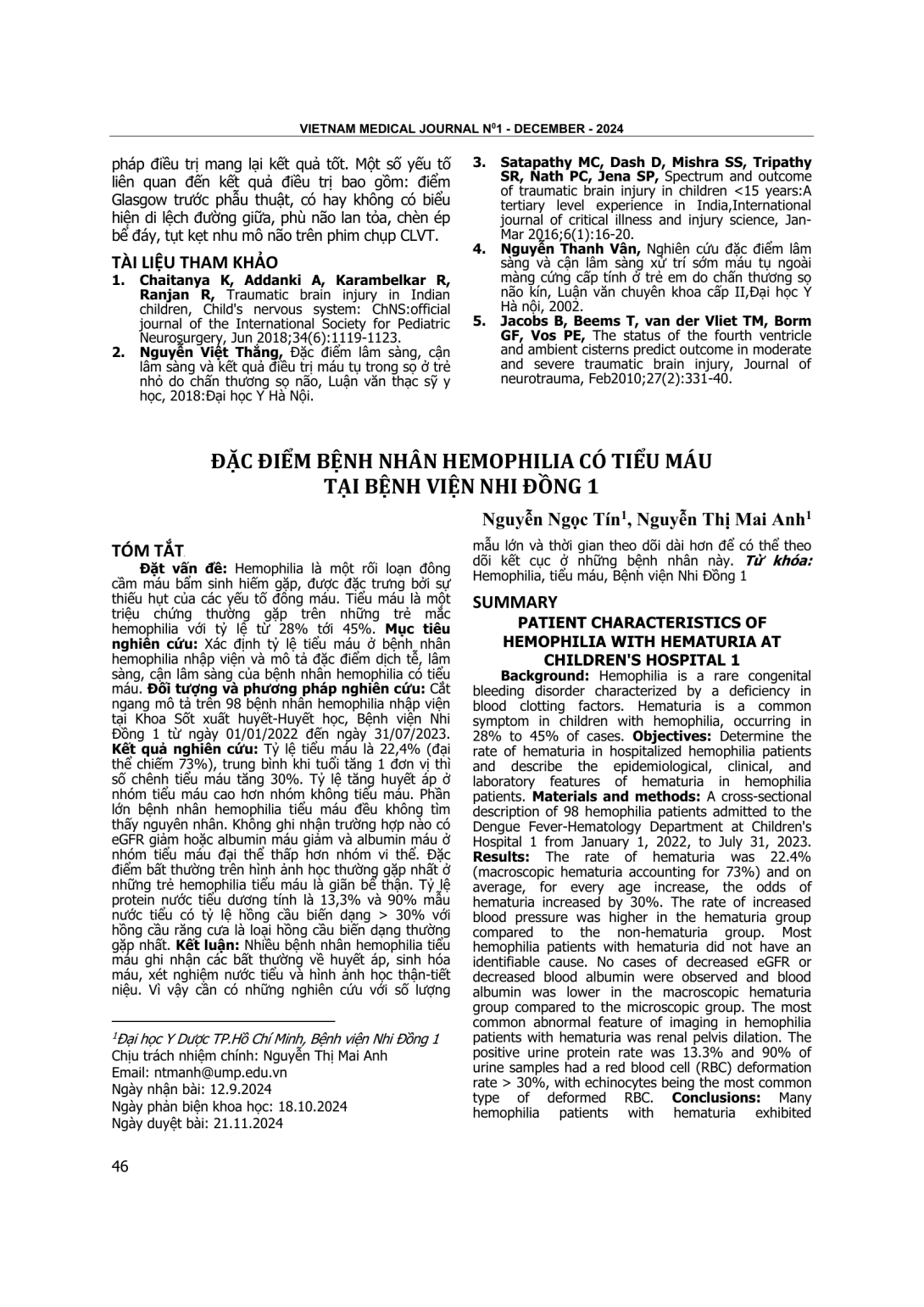
Xác định tỷ lệ tiểu máu ở bệnh nhân hemophilia nhập viện và mô tả đặc điểm dịch tễ, lâm sàng, cận lâm sàng của bệnh nhân hemophilia có tiểu máu. Đối tượng và phương pháp nghiên cứu: Cắt ngang mô tả trên 98 bệnh nhân hemophilia nhập viện tại Khoa Sốt xuất huyết-Huyết học, Bệnh viện Nhi Đồng 1 từ ngày 01/01/2022 đến ngày 31/07/2023. Kết quả nghiên cứu: Tỷ lệ tiểu máu là 22,4% (đại thể chiếm 73%), trung bình khi tuổi tăng 1 đơn vị thì số chênh tiểu máu tăng 30%. Tỷ lệ tăng huyết áp ở nhóm tiểu máu cao hơn nhóm không tiểu máu. Phần lớn bệnh nhân hemophilia tiểu máu đều không tìm thấy nguyên nhân. Không ghi nhận trường hợp nào có eGFR giảm hoặc albumin máu giảm và albumin máu ở nhóm tiểu máu đại thể thấp hơn nhóm vi thể. Đặc điểm bất thường trên hình ảnh học thường gặp nhất ở những trẻ hemophilia tiểu máu là giãn bể thận. Tỷ lệ protein nước tiểu dương tính là 13,3% và 90% mẫu nước tiểu có tỷ lệ hồng cầu biến dạng > 30% với hồng cầu răng cưa là loại hồng cầu biến dạng thường gặp nhất. Kết luận: Nhiều bệnh nhân hemophilia tiểu máu ghi nhận các bất thường về huyết áp, sinh hóa máu, xét nghiệm nước tiểu và hình ảnh học thận-tiết niệu. Vì vậy cần có những nghiên cứu với số lượng mẫu lớn và thời gian theo dõi dài hơn để có thể theo dõi kết cục ở những bệnh nhân này.
Hemophilia is a rare congenital bleeding disorder characterized by a deficiency in blood clotting factors. Hematuria is a common symptom in children with hemophilia, occurring in 28% to 45% of cases. Objectives: Determine the rate of hematuria in hospitalized hemophilia patients and describe the epidemiological, clinical, and laboratory features of hematuria in hemophilia patients. Materials and methods: A cross-sectional description of 98 hemophilia patients admitted to the Dengue Fever-Hematology Department at Children's Hospital 1 from January 1, 2022, to July 31, 2023. Results: The rate of hematuria was 22.4% (macroscopic hematuria accounting for 73%) and on average, for every age increase, the odds of hematuria increased by 30%. The rate of increased blood pressure was higher in the hematuria group compared to the non-hematuria group. Most hemophilia patients with hematuria did not have an identifiable cause. No cases of decreased eGFR or decreased blood albumin were observed and blood albumin was lower in the macroscopic hematuria group compared to the microscopic group. The most common abnormal feature of imaging in hemophilia patients with hematuria was renal pelvis dilation. The positive urine protein rate was 13.3% and 90% of urine samples had a red blood cell (RBC) deformation rate > 30%, with echinocytes being the most common type of deformed RBC. Conclusions: Many hemophilia patients with hematuria exhibited abnormalities in blood pressure, blood biochemistry, urine tests, and renal-urinary imaging. Therefore, further studies with a larger sample size and longer follow-ups are needed to monitor the outcomes in these patients.
- Đăng nhập để gửi ý kiến
